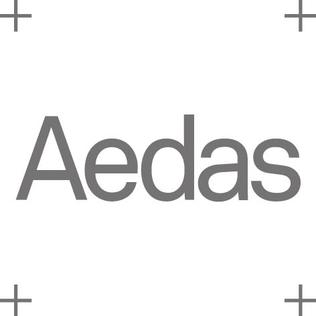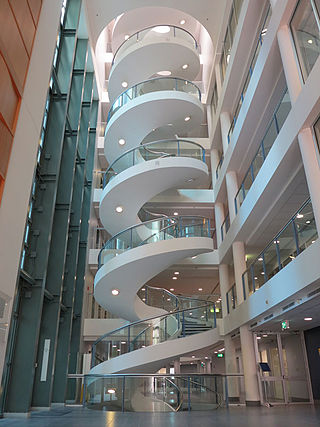
Harry Seidler was an Austrian-born Australian architect who is considered to be one of the leading exponents of Modernism's methodology in Australia and the first architect to fully express the principles of the Bauhaus in Australia.
The year 1988 in architecture involved some significant architectural events and new buildings.
The year 1980 in architecture involved some significant architectural events and new buildings.
Romaldo 'Aldo' Giurgola was an Italian academic, architect, professor, and author. Giurgola was born in Rome, Italy in 1920. After service in the Italian armed forces during World War II, he was educated at the Sapienza University of Rome. He studied architecture at the University of Rome, completing the equivalent of a B.Arch. with honors in 1949. That same year, he moved to the United States and received a master's degree in architecture from Columbia University. In 1954, Giurgola accepted a position as an assistant professor of architecture at the University of Pennsylvania. Shortly thereafter, Giurgola formed Mitchell/Giurgola Architects in Philadelphia with Ehrman B. Mitchell in 1958. In 1966, Giurgola became chair of the Columbia University School of Architecture and Planning in New York City, where he opened a second office of the firm. In 1980 under Giurgola's direction, the firm won an international competition to design a new Australian parliament building. Giurgola moved to Canberra, Australia to oversee the project. In 1989, after its completion and official opening in 1988, the Parliament House was recognised with the top award for public architecture in Australia.
Sir Roy Burman Grounds was an Australian architect. His early work included buildings influenced by the Moderne movement of the 1930s, and his later buildings of the 1950s and 1960s, such as the National Gallery of Victoria and the adjacent Victorian Arts Centre, cemented his legacy as a leader in Australian architecture.

The Australian Institute of Architects, officially the Royal Australian Institute of Architects, is Australia's professional body for architects. Its members use the post-nominals FRAIA (Fellow), ARAIA and RAIA. The Institute supports 14,000 members across Australia, including 550 Australian members who are based in architectural roles across 40 countries outside Australia. SONA is the national student-membership body of the Australian Institute of Architects. EmAGN represents architectural professionals within 15 years of graduation, as part of the Australian Institute of Architects.

Edmond and Corrigan is an Australian architectural firm based in Melbourne, Victoria, founded in the late 1970s by partners Maggie Edmond and Peter Corrigan, the firm's principals. The practice's work, both built and written, has been widely associated with the emergence of architectural postmodernism in Australia, an interest in suburbia and a search for an Australian architectural identity. Peter Corrigan taught design studios at RMIT University for over 30 years, until his death in December 2016.

Aedas is an architectural firm founded by the Welsh architect Keith Griffiths. Aedas has eleven international offices and provides services in architecture, interior design, urban design, masterplanning and graphic design. It was established in 2002.

Philip Sutton Cox is an Australian architect. Cox is the founding partner of Cox Architecture, one of the largest architectural practices in Australia.

Daryl Sanders Jackson is an Australian architect and the owner of an international architecture firm, Jackson Architecture. Jackson also became an associate professor at University of Melbourne and Deakin University.

Peter McIntyre is a Melbourne based Australian architect and educator.

Kenneth Frank Charles Woolley, BArch, Hon DSc Arch Sydney LFRAIA, FTSE, was an Australian architect. In a career spanning 60 years, he is best known for his contributions to project housing with Pettit and Sevitt, four time Wilkinson Award-winning architect, including three times for his own house, the first being the 1962 Woolley House in Mosman, and his longstanding partnership with Sydney Ancher and Bryce Mortlock. He is regarded as being a prominent figure in the development of the Sydney School movement and Australian vernacular building.
Zaha Hadid Architects is British architecture and design firm founded by Zaha Hadid (1950–2016), with its main office situated in Clerkenwell, London. After the death of "starchitect" Hadid, Patrik Schumacher became head of the firm, at the time with a staff of 400 with 36 projects across 21 countries.
Williams Boag, now known under the name WILLIAMS BOAG architects (WBa), is a Melbourne-based architectural practice that describes itself as a socially responsible design practice with a focus on modernist principles. Aesthetically Williams Boag's designs most closely resemble that of contemporary Scandinavian architecture. Williams Boag is a company with a single director, Peter Williams.
The Australia Forum is a proposed convention centre complex for Canberra, Australia. The project was first put forward in 2011, and in 2017 its future became uncertain when the ACT Government withdrew funding for the preparation of a business case for it.
The year 2018 in architecture involved some significant architectural events and new buildings.

Cameron Chisholm Nicol (CCN) is an Australian multi-disciplinary architecture practice. Established in Perth in 1884 by James William Wright, the firm has operated continuously in Western Australia since that time. The Brisbane office was opened in 1986. The two offices are no longer linked, and operate as separate entities.
Lovell Chen is an architectural practice and heritage consultancy founded by Peter Lovell and Kai Chen in Melbourne, Victoria, Australia. Founded in 1981 as Allom Lovell & Associates, the practice became Lovell Chen in 2005. They are known for their heritage, conservation and strategic planning work, and latterly for architecture. The practice Principals are Kai Chen, Kate Gray, Peter Lovell, Adam Mornement, Anne-Marie Treweeke, Milica Tumbas and Katherine White.

The Chongqing Science and Technology Museum is a science museum in the Jiangbei District of Chongqing, China.
The year 2020 in architecture involved some significant architectural events and new buildings.












